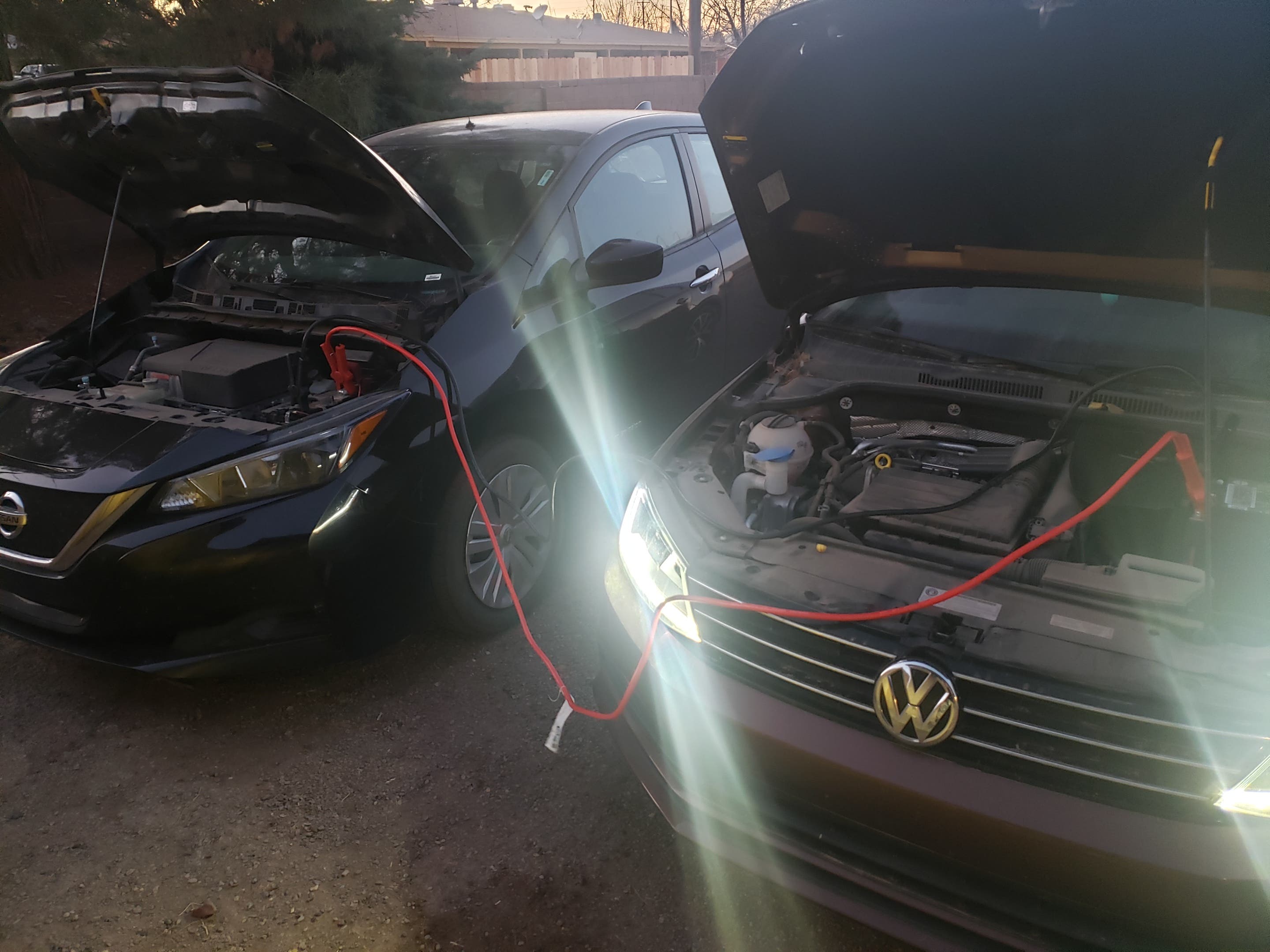A few days ago, James May put out a video showing us a minor problem he ran into that became something a lot more serious, and it can teach us something important about EVs: some of them are a lot harder to work on than others.
To quickly recap: His 12-volt battery went dead (“flat” in British parlance), and he went through over an hour of work just to get to the terminals and charge it. Not only did he have to call Tesla to figure out how to open the hood (or bonnet), but then he had to take a bunch of parts off to expose the terminals. Even part of the HVAC tubing had to come out to get at it.
Now, let’s compare this to the times I had to jump-start my Nissan LEAF.
When I would find my LEAF’s 12-volt battery had run flat, I had a much easier time of things than James May did. I pulled the little backup mechanical key out of the key fob, used it to unlock the driver’s door, and then pulled the mechanical hood release. I raised the hood, propped it up with the prop rod, and the battery was right there, ready to hook the cables to.
When I was done and the car was keeping itself going again, I unhooked the jumper cables, removed the prop rod, dropped the hood, and was ready to drive away. The whole process, from realizing the battery was dead (key fob didn’t work) to being ready to drive away takes 2-5 minutes, and that included getting to the Jetta’s battery (open hood, expose posts, clamp on the jumper cables).
So, in 1/12 the time James May spent, I was able to access the battery on not only one car, but two.
This was so easy, in fact, that I spent almost a year doing this 4-5 times a month. I was mad that the factory 12-volt battery was going bad after just a year and a half, so I limped along on it until I felt like I couldn’t handle it any longer. With the LEAF, it was easy enough to get away with this. Had this been a Model S, I would have changed the 12-volt out the first time it went dead prematurely. The difference in effort required is that drastic.
The F-150 Lightning’s design outdoes both Tesla and Nissan on this. It’s going to come with a MASSIVE frunk, but also makes it easy to get at the 12-volt battery.
It is technically called the MEGA POWER FRUNK and you can haul 400 pounds in it. #F150Lightning pic.twitter.com/db5o20EVjc
— Karl Henkel (@karlhenk) May 20, 2021
It’s hard to see in most of the images provided by Ford, but there’s a little access door at the back of the Mega Power Frunk that gives easy access to not only the 12-volt battery, but also other common maintenance items. It’s as fast to get to as my LEAF, but also gives lots of storage!
12-Volt Batteries Aren’t The Only Thing That’s Harder On Some EVs Than Others
It turns out that other common maintenance items are an issue, too. Sure, Tesla tells you that its vehicles don’t need maintenance, but it’s nice to be able to spot common problems before they become a major issue that strands you somewhere.
When Rich had his Model X in the garage to fix a CV joint issue (it appears that Tesla and Nissan have a mutual issue there), and they were under the car looking at things, the guy at Electrified Garage noticed that coolant was leaking near the front of the battery pack.
In the video (after they remove the rat’s nest, a common automotive problem for all brands) you’ll notice that the coolant tank is behind the cabin air filter. This means that just to check your coolant level and catch a leak before it becomes a problem, you’d have to remove everything in front of it. The pieces surrounding the frunk, the frunk carpet, frunk tub, and air filter must all come out to even be able to see the coolant level. If that’s too hard to do every few weeks (and you don’t have a clean garage where you see every little spot of fluid that comes from a car) you’ll instead discover the coolant leak when the Tesla shuts down and leaves you stranded.
In most cars (including my LEAF), the coolant tank is right there ready to check the level of as soon as you open the hood, and you can give it a quick check once a month along with other things you should inspect on your car regularly.
If a car (gas or electric) does spring a small coolant leak at a bad time, you can limp it home or limp it along for a few weeks by stopping off at Auto Bone and adding coolant to that reserve tank. Just be sure to drop some kitty litter where it leaks so no animals get poisoned by the coolant. Once again, most vehicles will let you do this by popping the hood, popping the cap, and then pouring in coolant. The Model X, on the other hand, requires a lot of work with tools just to get to the coolant cap and top it off.
Changing the cabin air filter (they had to order it in) took a whole lot more work than most EVs, and more cost for most people. Not only did the frunk tub had to come out, but Tesla expects people to change the whole assembly instead of just the filter’s paper element. Fortunately, Rich’s shop guy at Electrified Garage knew how to get around that issue. Most people will just generate some extra plastic waste and replace the whole assembly.
Once again, Ford got this right. The coolant tank is accessible inside the little door at the back of the F-150 Lightning’s frunk. Not a problem.
Maintenance Is Still A Good Idea For EVs
In theory, you can save a lot of money with a car that doesn’t need maintenance. If you’re a DIYer like me, it’s not a huge cost drain to perform some routine maintenance. If you are paying shops to do your routine maintenance, the costs add up fast.
In practice, though, not doing some routine maintenance isn’t smart. Checking for common problems every few weeks can prevent you from ending up with a big bill when things that you could have spotted early turn into big, expensive nightmares. It’s the old “an ounce of prevention is worth a pound of cure”.
Here’s an old Tesla maintenance checklist you can look at to get an idea of problems to look for, or you can view a video here going over maintenance items.
If you’re still a believer in Tesla’s “no maintenance” theory, it’s still a good idea to at least check for common problems before you go on a road trip. Checking coolant levels, giving the brakes an inspection (or a quick use), checking brake fluid, checking other hoses for cracks and leaks, and making sure the drive unit isn’t leaking any fluid are all good things to do.
All of this would be easier for owners if Tesla made these things more accessible, and hopefully they do at some point.
Featured image: Screenshot from the Rich Rebuilds video above, showing the cabin air filter and coolant reservoir.




You must be logged in to post a comment.